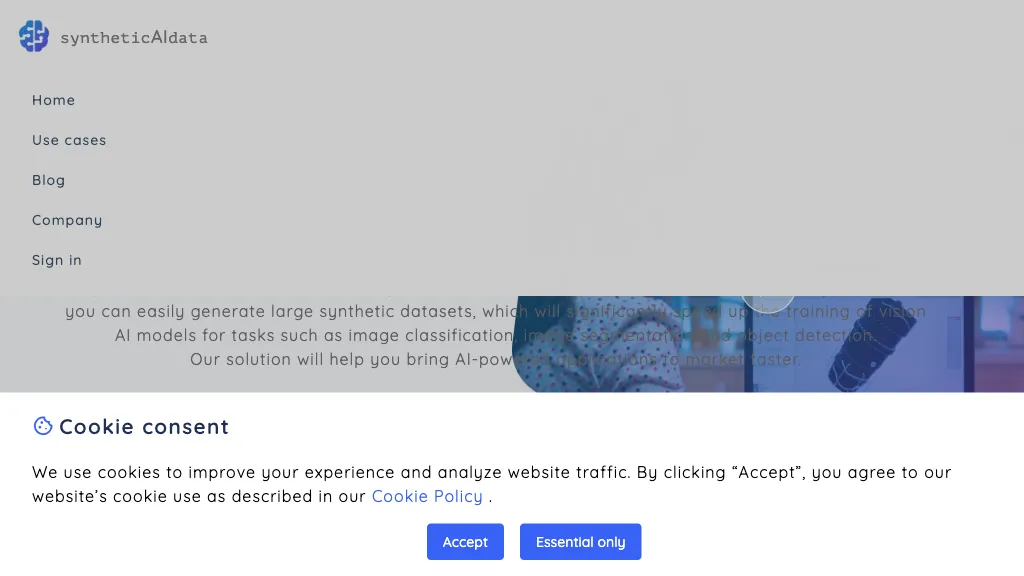What is SyntheticAIdata?
SyntheticAIdata is an advanced AI tool that is helping to develop cost-effective Vision AI models by easily eliciting synthetic data and creating enormous datasets. This augments the training and performance of Vision AI models for tasks in image classification, object recognition, and image segmentation, among others. It does so via a three-step process: upload the 3D model, set options in the middle, and then download the results. It is also available in the Microsoft start-up and NVIDIA Incept programs, and it can integrate with most cloud-based solutions.
Key Features and Benefits of SyntheticAIdata
With the broad set of features and benefits that SyntheticAIdata packs into it for users who want to build the most powerful vision AI models possible, here are some salient ones:
-
Model Generation:
Generate the models as required with ease. -
3D Models:
The real-life synthetic data is generated using 3D models. -
Options for Background and Lighting:
The backgrounds and lighting can be dynamically changed to simulate different environments. -
Image Annotation:
Easily annotate the images for easy training. -
Scalability:
Scale up your dataset generation with your ever-growing needs.
Synthetic AI data is made use of for the great set of advantages: cost reduction in terms of data generation, reduction of human errors in the generation of data, and to speed up the process concerning the development of models related to vision AI. It is known to stand out by generating high-quality synthetic data, and is accommodated by existing cloud services in relation to other unique features.
Use Cases and Applications of SyntheticAIdata
Synthetic AI data can be put to use in a wide variety of ways. Some use cases in detail involve among others:
-
Training Image Classification Model:
while trying to create training data for an image classification model; -
Object Detection:
creating extensive datasets for object detection tasks; -
Data Generation for Image Segmentation:
generating rich data in a dataset being used in an image segmentation project.
The industries in which SyntheticAIdata works are manufacturing, automotive, and retail, as they bring the most benefit through reduced costs and providing higher accuracy to AI models. The basic end users who access SyntheticAIdata include data scientists, AI engineers, AI developers, computer vision engineers, and machine learning engineers.
How to Use SyntheticAIdata
It is simple and easy to use SyntheticAIdata in just three simple steps:
-
Upload a 3D Model:
Start by uploading a 3D model that you want to use as a data point in the synthetic dataset you are about to create. -
Configure Options:
Configure the application further to show background, lighting, among other things, and include annotations as part of the data you want to have. -
Download Generated Data:
Upon completion of the configuration, download the generated synthetic dataset.
Opting for 3D model choices, playing around with different configurations, and verifying that indeed generated data is correct against real-world scenarios will carry the best results. Thanks to its intuitive user interface, navigation in the created experience will be flawless by any kind of user.
How SyntheticAIdata works
With the help of powerful algorithms and models, SyntheticAIdata is able to generate high-quality datasets in a synthesized manner. In this process, there are 3D models that work on simulating how the actual world could look if it were objects or environments. The tool can generate very diversified data with high realism against changes in background, lighting, and annotations to befit different training of the vision models. The process has been optimized for effective and scalable workflow in which users shall be able to produce large-scale datasets with ease.
SyntheticAIdata Pros and Cons
Like everything else, SyntheticAIdata has upsides and may have some downsides, too. Here are some pros and cons according to user feedback.
Pros
- Provides cost-effective solutions when it comes to generating synthetic data.
- There are smaller chances of making an error through human error while collecting the data.
- Can be scaled up as demands increase for more data.
- Integrates with a load of different cloud services.
Potential Drawbacks
- May require an initial investment in high-quality 3D models.
- Customization features could be somewhat difficult for newer users.
By user reviews, some of the positive points in favor of leveraging the tool are the ease of generating synthetic data and the high effectiveness of the outcome.
SyntheticAIdata FAQs
Q: What type of AI models can be created with SyntheticAIdata?
A: The set of vision AI models that can be created with SyntheticAIdata ranges across image classification, object detection, and image segmentation.
Is the learning curve steep when trying to use SyntheticAIdata?
Most of the application has been built to be very intuitive, and its new users can easily catch up with it, even when configuring advanced settings.
Is it possible to use SyntheticAIdata with my existing cloud services?
Yes, SyntheticAIdata can use almost any cloud-based service, which makes it flexible and user-friendly.
Which industries can benefit most with SyntheticAIdata?
A: The industries that benefit the most because of the cost reductions and increased AI model accuracy capabilities of the tool are manufacturing, automotive, and retail.










